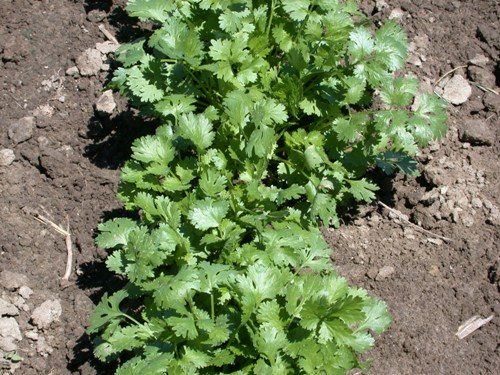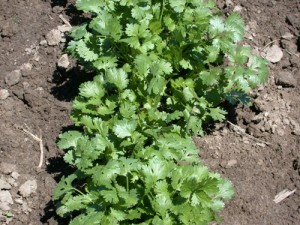Cilantro

 Question from Christina:
Question from Christina:
I have cilantro in a container outside…the problem is, it’s leaves have turned purple. I don’t know what I am doing wrong and can’t find my answer anywhere online. I would appreciate any tips you might have! I am in san diego, so it gets tons of sun, a bit too much so I keep it in partial shade part of the day. I also use a moisture meter so I won’t overwater it.
Answer from Pat:
Cilantro is an annual plant. It is not a perennial. An annual grows only for one season and then sets seeds and dies. Cilantro often goes purple when it is ready to set seed and die. If it is being grown in a small container with crowded roots, the plant will be stressed, it will think it’s going to die, so it will go purple and bolt (that is go to seed) prematurely in order to leave some progeny and continue its race.
Cilantro grows best in the ground or in a raised bed, not in a small container. When growing cilantro in a container make sure it is a large one, such as an 18-inch tub. Place the tub in full sun and water it regularly and enough to keep the ground evenly moist. (Whenever you water a plant in a container, you should water enough so that water pours out the bottom of the pot. This keeps the salts washed out. Salts also would ruin your crop.) Additionally when growing in a container, be sure to fertilize cilantro regularly. Potting mix contains no fertilizer. You must provide food for the plant so it will grow rapidly.
Since cilantro is an annual it won’t live forever. As soon as it is about 5 inches tall, begin harvesting with scissors and leave some growing so you can harvest more. Every time you harvest fertilize the plant to keep it growing. For example you could use fish emulsion mixed according to package directions.
In my Southern California garden I have only grown cilantro as a cool-season crop, planting it in fall or simply waiting until it volunteers and then allowing it to grow, and harvesting often. When it gets old and ready to bolt it often goes a bit purple. The purple leaves are not poisonous but they are strong tasting. The young leaves are the best part to eat. The older leaves are a different shape and generally too strong in flavor to eat unless cooked in soup.
In home gardens cilantro germinates easily in fall, grows well in cool temperatures and flourishes when grown throughout cool weather. When subjected to temperature swings such as hot days or dry soil, this can turn leaves purple also. Purple leaves often occur before the plants bolt or go to seed.
Grow cilantro in moist, fertile, well-drained soil and harvest it when young. If you cut off the top foliage often, the plants will continue to send up more growth, but eventually the plants, being annuals, will be worn out and will either die or bolt. Keep cilantro growing rapidly with regular applications of balanced organic fertilizer and adequate water and it should not have purple leaves.
To have regular harvests, plant successive crops throughout the season. If seeds won’t sprout due to warm soil temperatures, try freezing them overnight in a plastic bag prior to planting.


Thank you so much for your detailed email! Just got your book “Southern California Organic Gardening”…it’s awesome!
It’s lovely that you wrote me back. Thank you!
Many people are gardening today who did not grow up in gardening families and who have never gardened before. This may give some new gardeners an unsure feeling with plants, even though they desperately want to succeed. Garden plants, on the other hand, especially vegetables and herbs, are anxious to please us. They are eager to grow for anyone who tries to grow them. If plants had emotions they would love us with a purple passion. They would want with their whole heart, if they had a heart, to be extremely pleasing to us because we human beings are the only creatures who plant them, feed them, cultivate them, protect them from pests, store their seeds, and plant them again. We even have whole companies who put their pretty portraits on packages and distribute them around the globe. Gardeners are nature’s best gift to garden plants because we care for them as if we were their mothers and fathers all rolled into one. The very act of selecting, growing, and caring for a plant will eventually teach you everything you need to know about that particular plant in order to keep it alive and flourishing.
I would like to say to every would-be gardener: “Be not afraid of plants! Plants want to please us. Many of them even want to give up their lives to us in order to feed us. All we have to do in return is to plant them and care for them, according to their individual needs. This is how we love plants and how plants love us.”
This has been called the Water Planet. Maybe it should really be called the Plant Planet.
This looks great! And looks like a lot of fun. The wires on the bottom sound like a good idea, for aminals. But would the wires disrupt any of the root vegetables, such as carrots? Or maybe they wouldn’t go down that far, since you have a double layer of a box.
Galvanized wire hardware cloth does not disrupt roots of vegetables. Raised beds should be at least one foot deep and two or three feet deep is better.
Thank you for this reply!! I just planted my organic garden (Temecula) and have always had trouble with cilantro!
It has not been in the ground for two weeks…and turning purple! Cilantro is my favorite and I am going to try again and use your tips.
Everything else is doing well; cucumber, 4 varieties of tomatoes, herbs, zuchinni arugula 🙂
Always plant herbs and vegetables according to the seasons of year. Plant cool-season vegetables and herbs in fall and winter and harvest them throughout fall, winter,
and spring and plant summer vegetables and herbs in spring and summer. Cilantro is not a summer herb. It is an annual cool-season (winter) herb. Plant cilantro in fall and grow it as a winter crop and it will not turn purple. Hot temperatures and longer days with shorter nights will turn it purple. It is not the right herb to grow it in summer with tomatoes and zucchini. Plant basil instead, which is a summer annual herb and goes well with tomatoes and zucchini. You can also plant thyme, sage, parsley, rosemary, oregano, and summer savory now. Parsley is a biennial, summer-savory is an annual, but the others are perennials. Daytime temperatures are too hot in Temecula now in late April for growing cilantro. Arugula is also a cool-season annual. It too will most likely give you problems now and go to seed soon. The leaves are likely to taste very strong. When cilantro and arugula go to seed, we can use some of the flowers in salads but allow many to remain since these herbs seed themselves. Next fall these seeds will germinate and you will get a bonus of little arugula and cilantro plants springing up from the ground with no work from you and they will appear at exactly the correct time for planting them next fall. Borage is yet another cool-season herb to plant next fall and from then on it will seed itself season after season in your garden providing young leaves to chop in salads and lovely blue flowers to sprinkle on top.
Hi Pat,
Is it too soon to start Cilantro, Spinach, Snap Peas, Bok Choy and Beets from seed for a winter crop? I live in Rancho Bernardo and garden exclusively in huge pots with fresh potting soil. Right now I receive about 7 hours of sun per day in my “pot” farm.
The first planting day for cool-season vegetables is September 1. All the plants you named are winter or cool-season crops. However, beet is also one of the vegetables that can be planted year round. Do not plant cilantro, spinach, snap peas or bok choy until September 1, but you can plant beets any day year-round so that means now in August is fine. Plant all these crops in well prepared garden soil or in raised beds or containers exactly where you want them to grow.